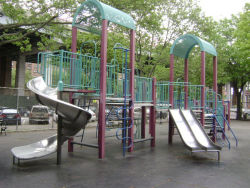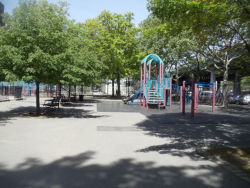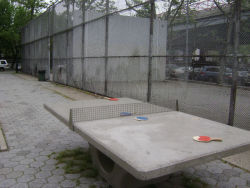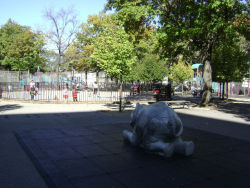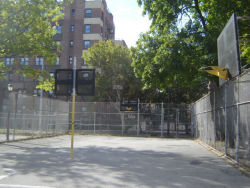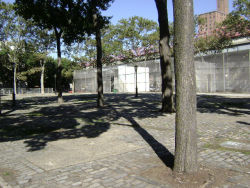Luther Gulick Park
The Daily Plant : Wednesday, August 13, 2003
SPOTLIGHT ON: LUTHER GULICK PLAYGROUND
Luther Halsey Gulick, III (1865-1918) was an educator, reformer, and community leader who is best remembered as the "Godfather of Basketball." As a physical education director at the Springfield, Massachusetts Young Men’s Christian Association, he challenged colleague James Naismith in the autumn of 1891 to concoct a game that could be played indoors during the winter months. On December 21 of that year, Naismith presented Gulick with a soccer ball and two peach baskets, and the game of basketball was born. In 1959, Gulick was inducted into the Basketball Hall of Fame for his role as a "contributor" to the sport.
Gulick, whose belief in a trilogy of mind, body, and spirit inspired the YMCA’s inverted triangle design, vigorously promoted physical education in New York City public schools and supported the concept of city playgrounds. In 1903, he founded the Public School Athletic League to bring organized team sports to youths in New York City. In 1910, he and his wife Charlotte co-founded the Campfire Girls, an organization that extended to young women opportunities similar to those offered by the Boy Scouts, which had been formed one year earlier. This group was one of the first such organizations not affiliated with a religious institution and represented Gulick’s extensive and evenhanded interest in making outdoor and sporting pursuits available to all young people.
Gulick’s nephew Dr. Luther Halsey Gulick (1892-1993), who shared his uncle’s name, also shares the distinction of having this playground named for him. From 1921 to 1961, Dr. Gulick served as president of the Institute for Public Administration (IPA), the first American organization formed to promote scientific management of government. President Franklin Roosevelt appointed Dr. Gulick to serve on the Committee on Administrative Management, a three-member advisory board that convened in 1936 and 1937 to reorganize the executive branch of the Federal Government. In addition to advising President Roosevelt and two New York City mayors, Dr. Gulick taught for eleven years at Columbia University, his alma mater. The IPA has established the title Luther Gulick Scholar in Residence to honor distinguished associates of the Institute.
Luther Gulick Playground borders historic "Willett Street/Bialystoker Place," named after Marinus Willett, Revolutionary War hero and New York City mayor from 1807 to 1808, and Bialystoker Synagogue, a religious landmark up the block. Erected in 1826 as the Willett Street Methodist Episcopal Church, the building has served as the Bialystoker Synagogue since its sale in 1905 to an immigrant Jewish congregation from Bialystok, Poland. The history of the synagogue mirrors the changes occurring in the neighborhood at the turn of the century when thousands of Eastern European Jews moved to the area.
The park itself has had some significant changes since its acquisition in 1931. When the city purchased the site, Parks Commissioner John E. Sheehy proposed to name the property in honor of Gulick. However, at a 1933 convention the Board of Aldermen moved to name it after Bernard Downing, the recently deceased minority leader of the New York State Senate. The park was known as Bernard Downing Playground from its opening in 1933 until 1985 when the playground was renamed to honor both Gulicks’ civic contributions. As well as undergoing a name change, the park has benefited from extensive renovations in recent years. In 1999, nearly $200,000 was allotted to a reconstruction effort that provided new asphalt pavement, modular play equipment, a sprinkler system, and a roller-skating area. Yet older attractions remain: visitors can still sit in the shade of the pin oak and London Plane trees, or, with the park’s first namesake in mind, play a game of basketball.
QUOTATION FOR THE DAY
"I’ve lived a life that’s full, I traveled each and ev’ry highway,
And more, much more than this, I did it my way."
Paul Anka
(b. 1941)
Check out your park's Vital Signs
Clean & Safe
Green & Resilient
Empowered & Engaged Users
Share your feedback or learn more about how this park is part of a
Vital Park System

